During the era of Stalinist Russia, it was a common practice to revise Soviet history by expunging inconvenient individuals, frequently men and women who had initially supported the Communist Revolution in its early stages but had later incurred the disapproval of Stalin.
Trotsky Addresses the Crowds
On the steps outside the Bolshoi Theater in May, 1920 – to the right we can see Trotsky, with Kamenev partly obscured behind him. The falsification of this photograph is probably the first and certainly the most famous example of Stalinist retouching.
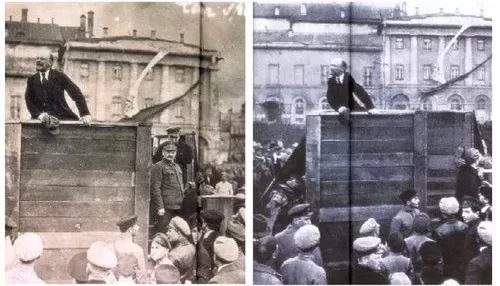

The original photograph, achieved icon status, while Lenin was still alive and Trotsky still had power. After Trotsky’s downfall, the photograph was never again shown in its entirety in the USSR. Even during the Gorbachev period the photo was cropped to eliminate Trotsky and Kamenev.
Soviet Picture Editing in the 1930’s
A photograph from 1934 Russian edition of the album “Ten Years of Uzbekistan” shows the crude defacing of three members of the Central Committee.
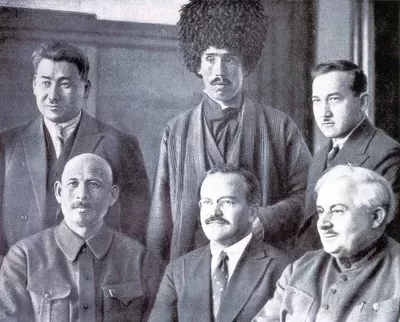

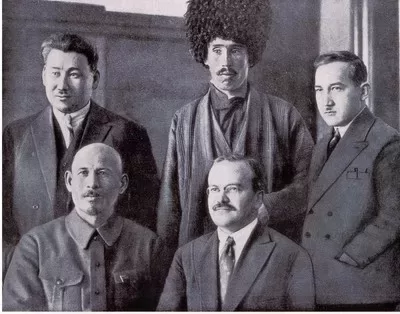

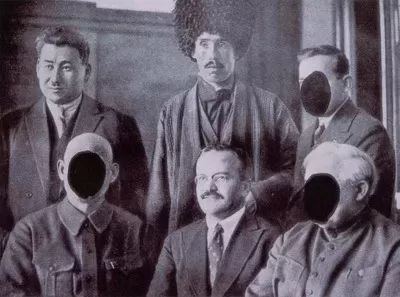

The one on the front right, Yenukidze was one of the last Old Bolsheviks to be murdered along with eight members of his family. The man in the center front row is Molotov. He managed to survive until the very end of the Stalinist regime. However, Stalin did imprison his wife.
Stalin Cult of Personality
From the mid-1930’s the Stalinist propaganda machine churned out thousands of sculptures, paintings, and drawings to exaggerate the closeness of his relationship with Lenin. The photograph of Lenin and Stalin near Moscow in 1922 [top left] bears every sign of having been faked. The ponderous sculpture made in 1938 based on the faked photograph [top right]. Below the top two pictures are other examples of the Stalin-Lenin exaggeration.
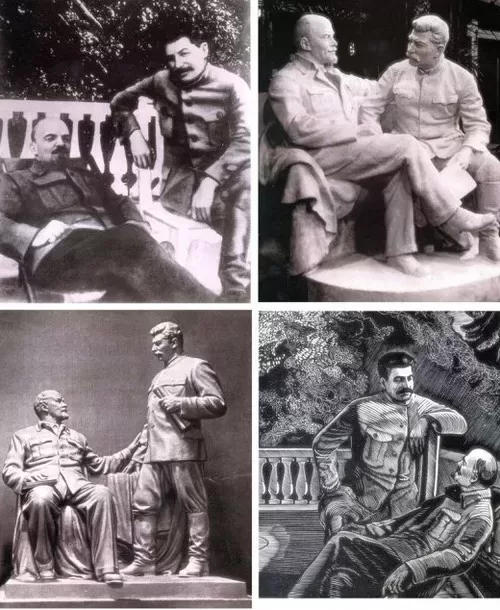

Further Reading: The Commissar Vanishes: The Falsification of Photographs and Art in Stalin’s Russia
Peshkov Reappears
Standing behind Lenin and his chess partner Bogdanov, and next to Gorky [hat on and hand in chin] is Zinovii Peshkov.
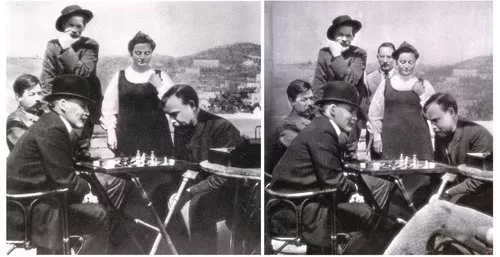

In the first picture Peshkov had disappeared, while in the next picture he reappears. There is no explanation for this disappearance- reappearance. Nor is there any explanation of the woman’s skirted knee in the right hand picture.
Lenin moves
Vladamir Lenin is pictured standing on the bed of a truck addressing a crowd in Red Square. In the original picture, Tibor Samuelli, a special envoy from the Hungarian revolutionary government, stands behind the leader.
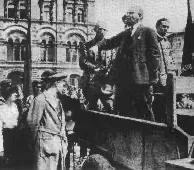

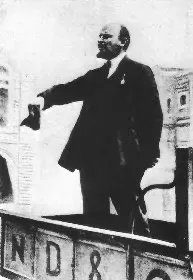

Later, under Stalin’s regime, the picture was reissued but this time without Samuelli. Because he did not want any connection to the internationalization of the Bolshevik revolution, Stalin remade history with a brush and ink.
The Conspirators
Meeting in St. Petersburg in February 1897 with Lenin. Left standing is Alexander Marchenko. Along with the others Marchenko was exiled for 3 years in Siberia. Returning from exile in 1900 he abandoned revolutionary politics. In 1929 he was arrested, wrongfully accused of being a “wrecker,” and executed in 1930.
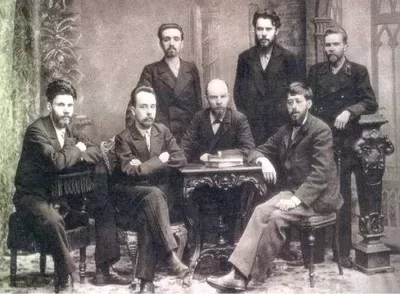

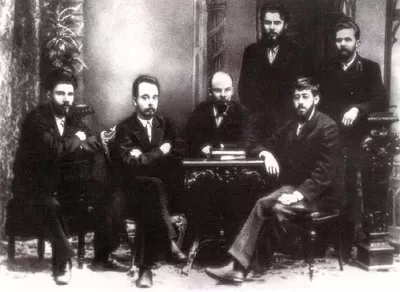

For 30 years he was air-brushed out of the photo whenever it was reproduced. In 1958 he was rehabilitated, at which time his presence was allowed to re-appear.
The Commissar Vanishes
Lenin and Trotsky [center, top of stairs] celebrating second anniversary of the revolution in November 1919.
![soviet06-500 - 1EarthMedia Lenin and Trotsky [center, top of stairs] celebrating second anniversary of the revolution in November 1919. A heavily retouched version was published in 1967. Trotsky has been air-brushed out.](https://1earthmedia.com/wp-content/uploads/2022/12/soviet06-500-jpeg-webp.webp)
![soviet06-500 - 1EarthMedia Lenin and Trotsky [center, top of stairs] celebrating second anniversary of the revolution in November 1919. A heavily retouched version was published in 1967. Trotsky has been air-brushed out.](https://1earthmedia.com/wp-content/uploads/2022/12/soviet06-500-jpeg-webp.webp)
A heavily retouched version was published in 1967. Trotsky has been air-brushed out.
Enemy of the People
Above left, participants of the 11th Congress, Moscow, 1922. Left of Stalin is Grigorii Petrovsky, and Sergo Ordjonikidze.
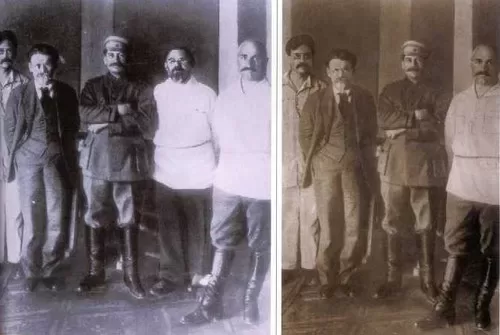

When this photo was taken Stalin had just been appointed General Secretary. The retouched photo on the right was published in connection with Stalin’s 60th birthday in 1939. There is no longer room for Petrovsky or Ordjonikidze. Petrovsky was sacked from the Central Committee in 1928, accused of having connections with “enemies of the people.” Notice how Ordjonikidze has moved closer to the Boss.
Further Reading: The Commissar Vanishes: The Falsification of Photographs and Art in Stalin’s Russia
Four, Three, Two, One…
Original photo included from left to right: Anippov, Stalin, Kirov, and Shvernik. Taken in Leningrad in 1926, celebrating the defeat of Zinoviev’s anti-Stalinist opposition. The photo of three reveals the disappearance of Antipov [the chandelier has also been eliminated]. Antipov had joined the Bolsheviks in 1912, chairman of the Petrograd Cheka in 1918, and later prime minister Molotov’s secretary. Arrested and sent to prison where he was the last Stalinist cadre to be shot in August, 1941.
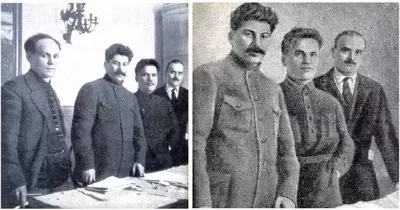

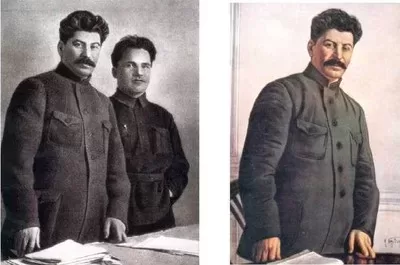

In the next picture, Shevernik was erased when the photo was used in 1949 for a short biography of Stalin. Finally, an oil painting by Brodsky based on the original photo. Stalin the executioner alone remains.
Long-term Friendships
This group shot, taken at the 14th Party Conference in April, 1925 is a classic example of Stalinist photographic manipulation. Only one of Stalin’s comrades in this picture would die from natural causes.
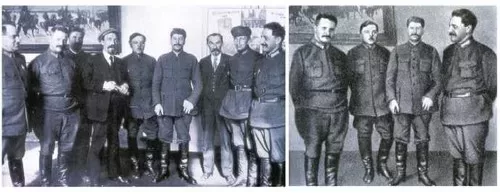

The same photograph published in 2 biographies of Stalin that appeared in 1939 and 1949, has been retouched and rearranged to reduce the group to four, 60% of those present were erased from history.
| The Commissar Vanishes: The Falsification of Photographs and Art in Stalin’s Russia New Edition Paperback – Illustrated, September 2, 2014 Brand new edition of David King’s lauded visual history. A unique and brilliant study into the doctoring and propogandising of Soviet photographs by Stalin’s regime. From the creator of the award-winning Red Star Over Russia. |
The Cult of Stalin and Propaganda
A cult of personality is the creation of a heroic or godlike public image through mass media and propaganda. Cults of personality are usually found in dictatorships and backward nations. The main reason to create a cult of personality is to obtain undying devotion of the people.
When people started worshiping Stalin as a god, he was given ultimate power. Through the cult of personality Stalin was able to set up his personal dictatorship and run unopposed and unquestioned. Due to the small number of people who did oppose him he had no problem killing them.
There are 4 main ways Stalin’s cult of personality was created:
- Censorship of anything that might reflect badly on Stalin
- Propaganda everywhere – pictures, statues, continuous praise and applause, Places named after him
- Word of mouth: Mothers taught their children that Stalin was ‘the wisest man of the age’
- History books and photographs were changed to make him the hero of the Revolution, and obliterate the names of purged people (e.g. Trotsky).
The main reason for propaganda was pretty much the same as that for the cult of personality, provided a better grip on power, but propaganda also had a wider range of uses:
- To establish a personal dictatorship
- To support, build and expand soviet power
- To attack enemies
- To control people
- To increase the war effort
- Create a feeling of unison
There were 7 main ways in which propaganda was spread:
- Posters
- Art
- Literature
- Film
- News
- Education
- Youth groups
The most effective form of propaganda was news reels:
- propaganda was be easily disguised and broadcast as news
- popularize and support the state and its decisions (ex. masked the failure of the 5 year plan)
Stalin deemed education to be a vital part of c being a communist, because if children are taught to be communists the brain washing is more effective.
Stalin reformed the education system when he came to power. This reform was good for the people and made education more effective and accessible but I also contained some reforms that could be called introducing propaganda into the school system:
- Communism and Stalin were fused into most subjects
- Some subjects were rewritten Ex. history, Stalin was given a greater part in the revolution
- train young people for slots in the economic, social, political and cultural life of the state
- Uniforms were introduced to create the feeling on unity
Youth groups were another form of propaganda implemented on children:
- Children were instructed to follow the party’s ideas
- But also did fun activities
- Shared a common uniform to once again create a feeling on unity
- Youth groups were very popular
- most famous Russian youth group was Communist League of Youth
- over 9 million members
- Children from youth groups were frequently photographed with Stalin
The use of propaganda was vital for the creation of Stalin’s cult of personality and one of the more important parts if it was how Stalin associated himself with Lenin after his death:
- Stalin embalmed Lenin against his wives wishes
- Created a cult round Lenin’s death despite Lenin’s ideals
- Associated himself with Lenin
- Declared himself Lenin’s natural successor
Stalin did all this so that he could then transfer Lenin’s cult of personality onto him self. He was successful and this brought about the era of Stalinization:
- Stalin was everywhere:
- Every house hold had a picture of Lenin and Stalin
- Constant parades were held in his honor
- Streets were filled with huge posters
- Stalin’s statues were raised everywhere
- He was given titles such as “Coryphaeus of Science,” “Father of Nations,” “Brilliant Genius of Humanity,” “Great Architect of Communism,” “Gardener of Human Happiness,”
- Soviet history rewritten to provide himself a more significant role in the revolution.
- Stalin was even included in the national anthem
To conclude:
- The Russian people shouldn’t be blamed for the atrocities that were that were made possible through their support of the regime and Stalin
- Continues propaganda effectively brain washed and clouded their judgment
- They truly believed that Stalin was unaware of the crimes on humanity that became so banal during his rule and though he really worked for their interest
Related stories
See our series on Propaganda, Fake News, Fake Photos, Photoshop, AI Artificial Intelligence
Truth in Political Advertising Laws needed
Barbie® plastic-free MyCelia™ EcoWarrior climate activist
Police forensic artists explain Missing Persons age progressed images
Is it a fake photo Prince Andrew, Virginia Giuffre, and Ghislaine Maxwell







